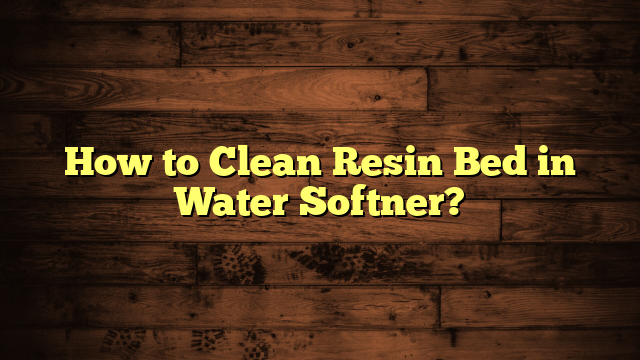How Does Water Softner Works?
Hard water can seem harmless, but its hidden effects on your home and appliances can be quite damaging. You might wonder how a simple device can tackle such a complex issue. A water softener uses a process called ion exchange to effectively reduce the mineral content in your water, replacing troublesome calcium and magnesium with sodium ions. But how exactly does this process work, and what are the implications for your household? Understanding these details can help you make informed decisions about your water quality.
Key Takeaways
- A water softener uses ion exchange to replace calcium and magnesium ions in hard water with sodium ions.
- Water passes through resin beads that capture hardness minerals, allowing softened water to flow out.
- The brine tank stores a salt solution, which is used to regenerate the resin beads, restoring their effectiveness.
- A control panel manages the regeneration cycles and monitors salt levels for optimal performance.
- Softened water enhances cleaning, prevents mineral buildup in appliances, and improves overall water quality in the home.
Understanding Hard Water
Often, you mightn't realize the impact of hard water until it starts causing issues in your home. Hard water contains high levels of minerals, primarily calcium and magnesium, which alter its water composition. This mineral buildup can lead to various problems that are often overlooked initially.
For instance, you might notice that your soap doesn't lather well or that your dishes come out of the dishwasher with stubborn spots. These issues arise because the minerals in hard water interfere with soap's ability to clean effectively.
Over time, you may even spot white scaling on faucets and showerheads, a telltale sign of mineral deposits accumulating.
Additionally, hard water can affect your appliances. Water heaters and dishwashers can become less efficient as mineral buildup clogs their inner workings, leading to increased energy costs and potential breakdowns.
You might find yourself frequently cleaning or replacing fixtures due to this persistent buildup.
Understanding hard water's impact on your home is essential. By recognizing these signs, you can take steps to address the issue before it escalates, ensuring your home remains comfortable and your appliances function effectively.
What Is a Water Softener?
A water softener is a device designed to reduce hard water's mineral content, making your water gentler on appliances and your skin.
By using a process called ion exchange, it replaces calcium and magnesium ions with sodium ions, effectively softening the water.
Understanding how this works can help you appreciate the benefits of having a water softener in your home.
Hard Water Explained
Hard water, found in many homes, contains high levels of minerals like calcium and magnesium, which can create various issues. You mightn't realize it, but hard water causes significant problems in your daily life. From soap scum to clogged pipes, understanding hard water effects is crucial for maintaining your home.
Here are three common issues caused by hard water:
- Soap Inefficiency: Hard water makes it difficult for soap to lather, leaving you feeling unclean after washing.
- Stains and Deposits: You'll often notice unsightly stains on your faucets, dishes, and showerheads, making them look dirty and unkempt.
- Appliance Damage: Over time, the mineral buildup can damage your appliances, like dishwashers and water heaters, leading to costly repairs or replacements.
Recognizing these hard water causes and effects can empower you to take action.
Whether you choose to install a water softener or adopt other solutions, addressing hard water is essential for improving your home's water quality and prolonging the life of your appliances.
Ion Exchange Process
Water softeners play a crucial role in transforming hard water into a more manageable resource. They utilize a process called ion exchange, which is essential for removing unwanted minerals from your water.
When hard water passes through the softener, it encounters resin beads coated with softening minerals, typically sodium or potassium. As the water flows through these beads, the hard minerals—like calcium and magnesium—attach themselves to the resin, while the softening minerals are released into the water.
This exchange effectively reduces the concentration of hard minerals, resulting in softened water that's gentler on your plumbing, appliances, and skin.
You might wonder why this matters. Softened water not only enhances the effectiveness of soaps and detergents, but it also helps prevent scale buildup in pipes and appliances.
This means fewer clogs and longer-lasting equipment. Plus, using soft water in your home can lead to cleaner dishes and softer laundry.
The Ion Exchange Process
When you install a water softener, you tap into a clever method called the ion exchange process. This process replaces hard water minerals like calcium and magnesium with softer sodium ions. The result? You get water that's easier on your appliances, plumbing, and skin!
Here's how the ion exchange process works:
- Resin Beads: Your water softener contains tiny resin beads that are charged with sodium ions. These beads attract the hard water minerals as water flows through.
- Exchange: As hard water passes through the resin, calcium and magnesium ions cling to the beads and displace the sodium ions. This is where the magic happens—you're literally exchanging one type of ion for another!
- Regeneration: After a while, the resin beads become saturated with calcium and magnesium. The softener then uses a salt solution to flush out these hard minerals, replenishing the sodium ions and getting the system ready for the next cycle.
Components of a Water Softener
Within a water softener, several key components work together to guarantee the effective removal of hard minerals. The heart of the system is the resin beads, which are specially designed to attract and hold onto the calcium and magnesium ions that cause hardness in water.
When hard water enters the softener, it flows through a tank filled with these resin beads, where the ion exchange process takes place.
Another vital part of the system is the brine tank. This tank holds a salt solution that replenishes the resin beads when they become saturated with hard minerals.
When the softener goes through its regeneration cycle, the brine solution is flushed through the resin beads, releasing the trapped hard minerals and replacing them with sodium ions. This process guarantees that the resin beads remain effective over time.
Together, the resin beads and brine tank make up the essential components of your water softener.
Regeneration Cycle Explained
During the regeneration cycle, your water softener refreshes the resin beads, guaranteeing they continue to effectively remove hard minerals from your water supply.
This cycle is vital for maintaining the efficiency of the system and typically occurs after a certain number of gallons have been processed, which relates to the regeneration frequency.
The regeneration process consists of three main stages:
- Backwash: Water flows in reverse through the resin tank, dislodging any accumulated minerals and debris. This step helps clean the resin beads and prepares them for the next phase.
- Brine Draw: A concentrated salt solution is drawn into the resin tank. The sodium ions from the salt replace the hard minerals that have built up on the resin beads, effectively recharging them.
- Rinse: The resin is rinsed with fresh water to remove excess brine and any remaining minerals. This final step guarantees that the softener is ready for the next cycle of water treatment.
Benefits of Water Softeners
Although you mightn't realize it, investing in a water softener can greatly enhance your daily life. One of the most noticeable benefits is improved lathering in soaps and shampoos. Softened water allows soaps to work more effectively, which means you'll use less product while achieving better results.
Imagine enjoying a rich, luxurious lather every time you wash your hair or take a shower.
Another significant advantage is reduced scaling in your appliances and plumbing. Hard water can lead to mineral buildup, causing inefficiencies and potential damage over time. With a water softener, you can prevent this scaling, which helps extend the life of your water heater, dishwasher, and other appliances.
This not only saves you money on repairs but also improves their performance.
You'll also notice softer skin and hair after bathing, as softened water prevents the drying effects of hard minerals. Plus, your clothes will feel cleaner and softer after washing, with less detergent needed.
Common Myths About Water Softeners
Water softeners are often surrounded by misconceptions that can lead to confusion about their benefits and functionality. Understanding the truth is essential for making informed decisions about your water quality. Here, we'll engage in some myth debunking and clarify common misconceptions:
- Softened water is unhealthy: Many believe that softened water is bad for health due to its sodium content. However, the sodium levels are minimal and generally safe for most people.
- Water softeners waste water: Another myth is that softeners waste a lot of water. In reality, modern systems are designed to be efficient, using considerably less water during regeneration compared to older models.
- Water softeners remove all minerals: Some think that water softeners eliminate all minerals from water. In truth, they primarily target calcium and magnesium, leaving beneficial minerals like potassium intact.
Maintenance Tips for Water Softeners
How do you keep your water softener running smoothly? Regular maintenance is key to ensuring its longevity and efficiency.
First, establish a maintenance schedule. Check the salt levels in your brine tank monthly, and refill when it's about one-third full. This simple step helps maintain peak performance.
Next, follow a cleaning procedure at least once a year. Start by rinsing the brine tank to remove any sludge or buildup. You can use a mixture of vinegar and water for a thorough clean.
Furthermore, inspect the resin beads in the mineral tank; if they appear discolored or worn out, consider replacing them.
Don't forget to check the filter screens, as they can accumulate debris over time. Cleaning them will improve water flow and efficiency.
Finally, keep an eye on the control panel for any error messages or alerts. Addressing these promptly can save you from larger issues down the line.
Frequently Asked Questions
Can Water Softeners Remove Heavy Metals From Water?
Water softeners aren't designed for heavy metal removal. They primarily improve water quality by reducing hardness. If you need heavy metal removal, consider additional filtration systems specifically meant for that purpose to guarantee safe drinking water.
How Long Does a Water Softener Last?
A water softener's lifespan typically ranges from 10 to 15 years. You can extend its life by following maintenance tips, like regularly cleaning the system and checking for salt levels, ensuring it operates efficiently for years.
What Is the Cost of Installing a Water Softener?
When considering water softener prices, you'll find that installation expenses can vary. Typically, you're looking at a range of $1,000 to $3,000, depending on the system and any additional plumbing work required.
Do Water Softeners Affect Drinking Water Taste?
Many believe water softeners alter taste perception. However, they mainly balance minerals, possibly making water taste smoother. You might notice a difference, but it often enhances your drinking experience rather than detracts from it.
Can You Use Water Softeners With Well Water?
Yes, you can use a water softener with well water. However, check the softener compatibility with your specific well water's mineral content to guarantee effective treatment and avoid potential issues with your system.
Conclusion
To summarize, a water softener is like a filter for your home's plumbing, transforming harsh, mineral-laden water into a gentle stream that protects your appliances and enhances your cleaning efforts. Think of it as giving your water a spa day—softening its edges and making it more pleasant to use. By understanding how these systems work and keeping up with maintenance, you can enjoy the benefits of soft water and prolong the life of your plumbing and fixtures.







